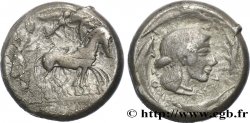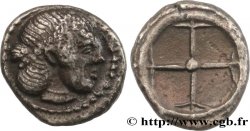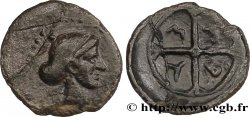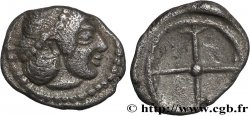bgr_350383 - SICILY - SYRACUSE Tétradrachme
недоступный.
Товар уже продан в нашем интернет-магазине (2017)
Цена: : 2 200.00 €
Товар уже продан в нашем интернет-магазине (2017)
Цена: : 2 200.00 €
Тип Tétradrachme
Дата: c. 475-470 AC.
Монетный двор / Город: Syracuse, Sicile
Металл: silver
Диаметр: 24 mm
Ориентация осей монеты: 2 h.
Вес: 16,93 g.
Редкость: R2
Комментарии о состоянии
Exemplaire sur un petit flan épais et régulier, légèrement ovale, bien centré des deux côtés. Coin de droit légèrement bouché sur l’aurige et la roue du char, autrement bien venu à la frappe. Très jolie tête d’Aréthuse au revers, bien venue à la frappe, de style fin servie par une magnifique patine de médaillier avec des reflets mordorés
Ссылки в каталоге: :
Bœhringer315 (A/151 - R/ 221) (3 ex.) - ANS.- - Randazzo Hoard470 - MIAMG.4873 var. (R2) (4500€) - Münich- - HGCS. 2/1307
Происхождение:
Cet exemplaire provient de la vente iNumis 2, n° 6 et de la collection d’Élisabeth
Лицевая сторона
Аверс: легенда: ANÉPIGRAPHE.
Аверс: описание: Bige au pas à droite, conduit par un aurige tenant les rênes et le kentron ; le bige est couronné par Niké volant à droite.
Обратная сторона
Реверс: Описание: Tête d'Aréthuse à droite, les cheveux relevés et retenus par un diadème de perles, entourée de quatre dauphins.
Реверс: легенда: SU-RA-KOS-IO-N
Реверс: перевод: (de Syracuse).
Комментарий
Mêmes coins que l’exemplaire de l’American Numismatic Society et que l’exemplaire de la collection Weber n° 1582. Même coin de droit que l’exemplaire de la collection Jameson I, 746.
Same dies as the American Numismatic Society specimen and the Weber Collection specimen No. 1582. Same obverse die as the Jameson Collection specimen I, 746
Same dies as the American Numismatic Society specimen and the Weber Collection specimen No. 1582. Same obverse die as the Jameson Collection specimen I, 746








 Cообщить об ошибке
Cообщить об ошибке Распечатать страницу
Распечатать страницу Отправить мой выбор
Отправить мой выбор Задать вопрос
Задать вопрос Consign / sell
Consign / sell
 Информация
Информация









